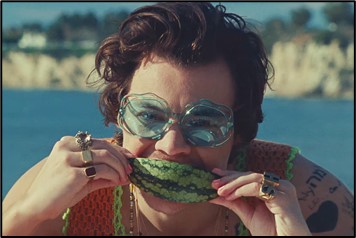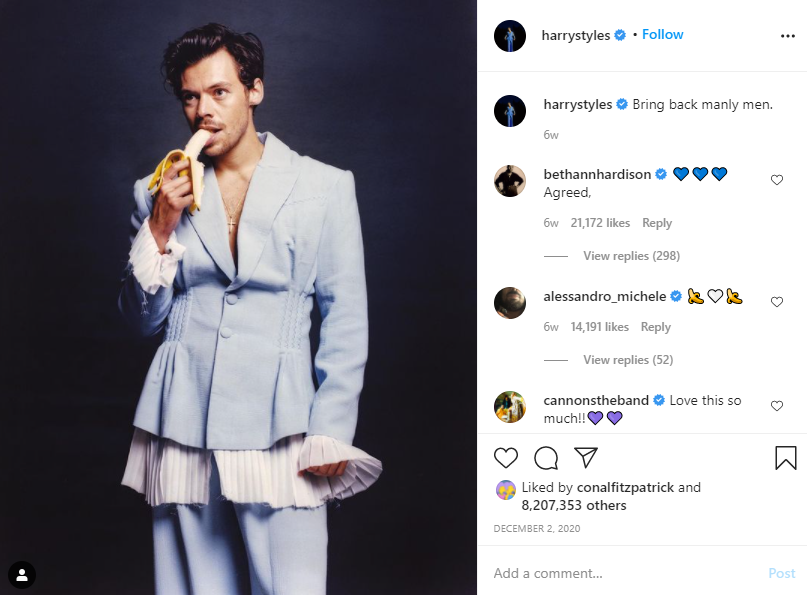
The journey from going in One Direction to leading his own.
Originally auditioning as a solo artist on X-Factor, 2010, Simon Cowell created the boyband One Direction and Harry Styles became one fifth of it. During their reign, they broke multiple billboard records, some previously held by the Beatles, and soared in international fame. That was up until 2016 when they eventually drew to a hiatus.
We have seen that old cliché happen time and time again – A band becomes famous, some members think they can do it alone, some members hearts are no longer in it, they split, and we see who champions as an individual solo artist – Beyoncé, Robbie Williams and Justin Timberlake come to mind.
Even at that, success as an individual celebrity does not necessarily mean achieving success as a solo musician. Take for example Victoria Beckham, she has cultivated a luxury fashion line in her name and has recently signed a, “£16 million Netflix series, offering exclusive insight into their lives.” (Coke 2020). Mel B also remains as a regular TV personality and the other three former spice girls? ‘Goodbye my friend’…
Thus, for those who survive the split, it is not merely the result of divination or pure talent, but rather a calculated effort to craft an individual image for the former band member. This image is crafted through a series of P.R. stunts and rebirth of Harry Styles has been no exception.
Striking while the iron is still hot, Styles launched a debut album in 2017, followed by an international tour that embedded the slogan, “Treat people with kindness.” In support of this message he donated, “$1.2 million of the profits to 62 charities, which included Time’s Up, Help Refugees and the We Love Manchester Emergency Fund.” (Bugler 2020). He is a humble personality and that is reflected in his good doings.
Another notable moment of his P.R. journey aligns with the designer Gucci and their 2019 campaign that embraced elements of the indie/hippie culture with odes to fluid sexuality and youth. This video visualises his transition from a teenage pop icon to a reborn man, carving out his own identity.
Am I personally biased toward the teenage crush that I haven’t outgrown? Absolutely, (maybe a little bit), not. Although I can appreciate the effort that has went into evolving his P.R. image, he has managed to stay relevant and grown alongside the milestones of his fanbase, e.g.) the journey through sexuality and figuring oneself out.
He has challenged traditional gender norms through numerous P.R. fashion statements, e.g.) The 2019 Met Gala:

And his recent cover on Vogue embodied further elements of femininity:

I think it would be insular to consider these P.R. activities as simple tactics to gain more attention, he reinforces this notion in a 2019 interview with Lamont, stating,
“I think it’s a very free, and freeing, time. I think people are asking, ‘Why not?’ a lot more. Which excites me. It’s not just clothes where lines have been blurred, it’s going across so many things. I think you can relate it to music, and how genres are blurring…”
Sexuality, too, I say.
“Yep,” says Styles. “Yep.”
Styles nods. “Am I sprinkling in nuggets of sexual ambiguity to try and be more interesting? No.”
It is a very liberating time for Harry Styles, and he aligns with current cultural trends towards liberation and individualism. His fashion cover with Vogue however, was criticized by US political figure Candice Owens as “bring back manly men.” And in retaliation, he sarcastically reposted the slogan in an Instagram post,

Although he handled the attack on his masculinity with great composure, this notion of famous solo artists challenging gender fashion norms isn’t something new. The former example of Harry Styles’ Instagram post is eerily reminiscent of this David Bowies image,

Many celebrities have used fashion to craft their unique identity and it offers many complementary P.R. activities. Harry Styles has gained much publicity regarding his image and he has stayed relevant in recent news by featuring on GQ’s Best-Dressed Men Of The Year list in 2020.
As well as being chart topping musician and influential fashion icon, Styles has also managed to gain regular appearances on talk shows, Saturday Night Live, The Graham Norton and The Ellen DeGeneres Show. Oh, and don’t forget that acting role in Christopher Nolan’s Dunkirk. Harry Styles has managed to gain some sort of monopoly in each of these sectors and his legitimacy as an individual, separate from his boyband image, has been achieved.
This transition is difficult to achieve and a wholistic P.R. strategy that incorporates a range of industries for support is needed. Lee 2020, States, “The transition from boy band member to adult man solo artist is not an easy one. The scramble to assert oneself as a legitimate, relevant musician can be full of pressure, and not everyone walks away with equal amounts of fame and success.” This is evident in her article, “2 Winners and 3 Losers from One Direction’s Solo Albums.”
Harry Styles has arguably risen as the most successful artist following the split and I believe this to be the result of talent, complemented with a selective P.R. strategy that has allowed him, “the rare ability to disappear for months, but, when he returns, it is with just as much momentum as when he left.” Bugler (2020).
Sara Lynch is a final year BSc in Communication, Management and Public Relations student at Ulster University – interning with Ulster University’s Access, Digital and Distributed Learning department. She can be found on LinkedIn and Twitter.